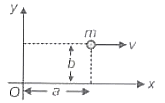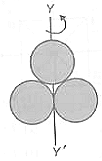A particle of mass m is moving with constant velocity v parallel to the x-axis as shown in the figure. Its angular momentum about origin O is

(1) mvb
(2) mva
(3)
(4) mv (a + b)

A particle of mass 5 kg is moving with a uniform speed 3 in XOY plane along the line Y = X + 4. The magnitude of its angular momentum about the origin is
(1) 40 units
(2) 60 units
(3) Zero
(4) 40 units
For equilibrium of the system, value of mass m should be

(1) 9 kg
(2) 15 kg
(3) 21 kg
(4) 1 kg
The moment of inertia of a body depends on
(1) The mass of the body
(2) The distribution of the mass in the body
(3) The axis of rotation of the body
(4) All of these
The two spheres, one of which is hollow and other solid, have identical masses and moment of inertia about their respective diameters. The ratio of their radi is given by
(1) 5 : 7
(2) 3 : 5
(3)
(4) 3 : 7
Three solid spheres each of mass P and radius Q are arranged as shown in fig. The moment of inertia of the arrangement about YY' axis

(1)
(2)
(3)
(4)
Three rods each of mass m and length L are joined to form an equilateral triangle as shown in the figure. What is the moment of inertia about an axis passing through the centre of mass of the system and perpendicular to the plane?

(1)
(2)
(3)
(4)
A thin wire of length l and mass m is bent in the form of a semicircle as shown. Its moment of inertia about an axis joining its free ends will be

(1) ml2
(2) Zero
(3)
(4)
A meter stick is held vertically with one end on the floor and is allowed to fall. The speed of the other end when it hits the floor assuming that the end at the floor does not slip is (g=9.8 m/s2)
(1) 3.2 m/s
(2) 5.4 m/s
(3) 7.6 m/s
(4) 9.2 m/s
A circular disc of mass 2 kg and radius 10 cm rolls without slipping with a speed 2 m/s. The total kinetic energy of disc is
(1) 10 J
(2) 6 J
(3) 2 J
(4) 4 J






